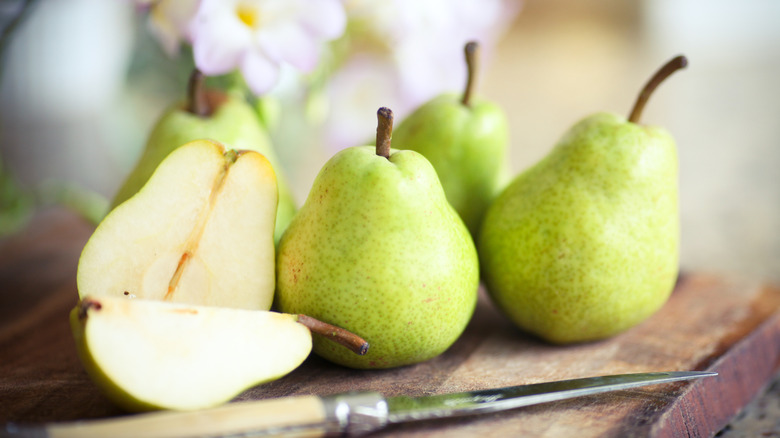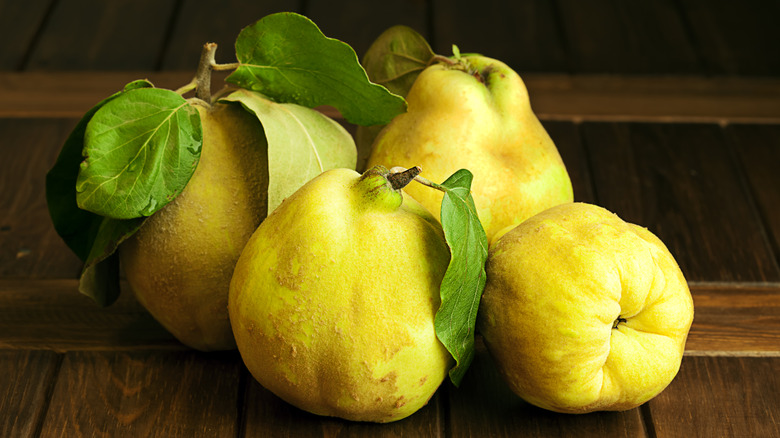How Exactly Does A Quince Differ From A Pear?
The quince plant is a part of the Rosaceae plant family, which we also have to thank for apples, almonds, raspberries, and even pears. While quince and pear are fruits of the same family, there are quite a few major differences between them that will become evident as soon as you take a look. A quince is a hard, lumpy, and even hairy fruit best enjoyed when it's cooked in some way. Meanwhile, a pear is a crisp, juicy, creamy, and sometimes grainy fruit that can be enjoyed fresh or incorporated into many dishes.
Due to its astringent nature, a quince can leave your mouth with a dry sensation that intensifies with each bite. Once cooked, however, that astringency is replaced with a lush, mouthwatering texture. Pears, on the other hand, are generally lauded as delicious whether they're enjoyed raw or cooked. One bite of a perfectly ripe pear reveals a buttery, juicy texture and mouth-watering sweetness that is a far cry from the texture and flavor of a raw quince.
Pear-fect attributes of pears
There are many varieties of pears with diverse variations in flavor, texture, and even appearance, which may be why it is so easy to confuse this lunch box classic with a quince. The skin of many pear varieties is arrayed from green to yellow, and sometimes even red. While some pears are buttery and sweet, others are tangy and firm, meaning there is a pear for every culinary purpose.
Pears may be hard when you pick one up from a supermarket produce department because they are meant to ripen off the branch, a process that happens best at room temperature. After allowing them to rest on the counter until they soften a bit, pears will be ready to use in many different appetizers and entrees. For instance, the fragrant sweetness of this fruit makes it the perfect supporting ingredient for a chicken or pork roast. Whether in a tarte tatin, pie, or crisp, pears are sure to deliver a pleasant moist sweetness when incorporated into a dessert. It is also no secret that these sweet fruits are easy to enjoy on their own when they've reached a perfectly ripe state.
Key notes for cooking quince
Quince is known for its complex and difficult-to-pin-down floral scent, with some comparing it to that of vanilla bean, guava, jasmine, and pear. Just as low and slow is the expert way to prepare short ribs, quince's flavor and texture are unlocked with a lengthy poach, simmer, or bake. As a bonus, the flesh will also shift from an off-white to a pink or rose hue as the quince cooks.
Slow-cooking quince with sugar, lemon juice, and spices like cinnamon, vanilla bean or vanilla extract creates ruby red poached goodness that pairs well with ice cream or other poached fruits. The resulting syrup from this process can also be reduced into a quince jelly. Marmalades, jams, and Spanish membrillo (quince paste) center quince's floral flavors and sweetness, making them perfect accents to cheeses on your charcuterie board.
Once cooked, quince will add pops of flavor that give a fragrant flair to a salad. The enchanting flavor of quince is sure to please when paired with pork, but this fruit also shines when included in baked goods. However you prepare quince, just be careful when slicing them as they are so firm that the knife can easily slip even when it's properly sharp.


